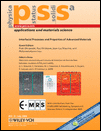High resolution transmission electron microscopy study on the nano-scale twinning of θ-NiMn precipitates in an Fe–Ni–Mn maraging alloy
Abstract
Precipitation of nanometer-sized fct θ-NiMn intermetallic compound was found to cause age hardening in Fe–10Ni–7Mn (wt%) maraging alloy during isothermal aging at 753 K. High resolution transmission electron microscopy was used to study the substructure of the fct θ-NiMn precipitates in the alloy after aging for 0.36 and 86.4 ks. Nano-scale twins on (111) planes were found in the precipitates of intial and later stages of aging. Precipitation of bcc β-NiMn at 753 K and subsequent martensitic transformation to fct θ-NiMn during cooling to room temperature was suggested. It was also indicated that precipitation of fct θ-NiMn at bcc iron matrix gives rise to high coherency strain energy. The (111) twinning is proposed to accommodate the strain energy of either martensitic transformation or coherency strain of precipitation reaction. (© 2006 WILEY-VCH Verlag GmbH & Co. KGaA, Weinheim)




